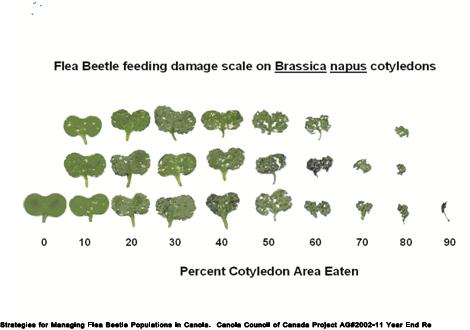Manitoba Insect and Disease Update: June 12, 2013
Compiled by:
- John Gavloski, Entomologist
Manitoba Agriculture, Food and Rural Initiatives
Phone: (204) 745-5668
Fax: (204) 745-5690. - Holly Derksen, Plant Pathologist
Manitoba Agriculture, Food and Rural Initiatives
Phone: (204) 750-4248
Fax: (204) 745-5690
To report observations on insects or plant pathogens that may be of interest or importance to farmers and agronomists in Manitoba, please send messages to the above contact address.
To be placed on an E-mail list so you will be notified immediately when new Manitoba Insect and Disease Updates are posted, please contact John Gavloski at the address or numbers listed above.
Recent Insect and Plant Pathogen Activity
Flea beetles in Canola: There have been some reports of insecticides being needed for flea beetle control, particularly in the Eastern and Central areas of Manitoba. A couple of the common questions that are being asked regarding flea beetle management are:
1) At what point can the plants compensate for flea beetle feeding and insecticide applications become uneconomical?
Yield is reduced most when plants are damaged during the seedling to second true leaf stage
(Bracken and Bucher. The Canadian Entomologist. 1986. 319-324). In this study yield was not reduced when plants reached the 3 to 4 leaf stage. So use this as a guideline when deciding whether an insecticide is really necessary.
Yield is reduced most when plants are damaged during the seedling to second true leaf stage
(Bracken and Bucher. The Canadian Entomologist. 1986. 319-324). In this study yield was not reduced when plants reached the 3 to 4 leaf stage. So use this as a guideline when deciding whether an insecticide is really necessary.
What level of feeding damage is needed for an insecticide application to likely be economical?
If the plants have not yet reached the 3 to 4 leaf stage, and there is at least 25% feeding injury, an insecticide may be economical. Not sure what 25% feeding injury looks like? The following figure may be helpful. It is normal to have a few feeding pits per plant, even when the seed treatments are still effective. So don’t be too alarmed by a few feeding pits.
If the plants have not yet reached the 3 to 4 leaf stage, and there is at least 25% feeding injury, an insecticide may be economical. Not sure what 25% feeding injury looks like? The following figure may be helpful. It is normal to have a few feeding pits per plant, even when the seed treatments are still effective. So don’t be too alarmed by a few feeding pits.

Tan Spot on wheat: There have been numerous reports of tan spot in wheat crops across the province. Cool to mild temperatures and precipitation events (or prolonged morning dews) are the ideal conditions for sporulation and infection by fungal pathogens, such as those that cause tan spot and septoria leaf spot. Infection at an early stage is not indicative of a season-long problem. Plants can grow out of early infections and the amount of disease symptoms on the flag leaf is still the main yield determinant. If infection at this early stage is severe, a fungicide application may be considered. Consult the Guide to Crop Protection for products labeled at this crop stage, appropriate rates, and use restrictions regarding the maximum number of applications in a season. Make your decision based on the current disease level, the upcoming forecast, as well as any fungicide applications you may wish to make later in the season. Consider leaving a test strip when making an early fungicide application to determine at harvest whether there was a yield benefit.
Cutworms: Spraying for cutworms has been reported from several areas of Manitoba; Starbuck, Elm Creek, Beausejour, and Strathclair. Some of the samples of redbacked and darksided cutworms that I have seen look like they could have a couple of weeks of feeding left. So do scout for cutworms.
Scouting tip: Dig around plants that have feeding damage or are clipped. Cutworms are nocturnal (feed at night), so you need to look in the soil.
Economic threshold: Varies with the crop, and most are nominal, meaning they are our best guess based on available information rather than based on research quantifying the impact of the insect on the crop. The following factsheet may help with species identification and provides some nominal thresholds.
http://www.gov.mb.ca/agriculture/crops/insects/cutworms-field-crops.html
http://www.gov.mb.ca/agriculture/crops/insects/cutworms-field-crops.html
Control tips: If control is necessary, applying insecticides as late in the day as possible is preferred if cutworms are the prime target. Sometimes only specific areas or patches of a field may need to be treated.
Grasshoppers: Grasshopper emergence has started. So it is good to monitor grasshopper emergence in areas that would have had green vegetation late last year, such as the grassy areas surrounding fields.
Surveys and Forecasts
Diamondback moth: Counts of diamondback moth in the pheromone-baited traps increased greatly in some of the traps in the Eastern region over the past week. Trap counts in the western part of Manitoba and the Interlake remain low, less than 10 in total. High counts have all been in the area near and east of the Red River, with most of the moths caught during the week of June 3-9. Highest counts to date are:
| Location | Total for season | Count during week of June 3-9 |
|---|---|---|
| Steinbach | 205 | 191 |
| Oldenburg | 146 | 106 |
| Beasejour | 96 | 91 |
| Emerson | 53 | 40 |
| Altona | 52 | 38 |
| Dencross | 50 | 47 |
| Carman | 38 | 29 |
